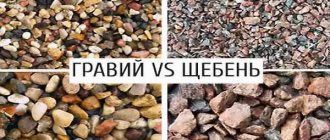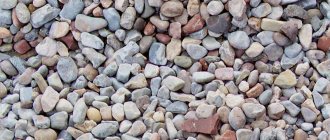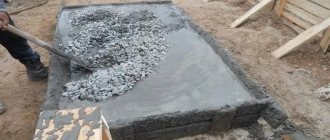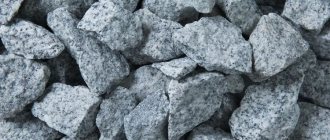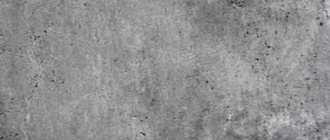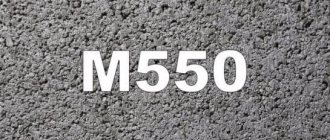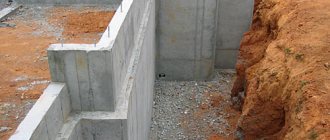So, dolomite crushed stone - what is it, what are its main features? Building materials obtained from sedimentary rocks are widely used in construction, which is explained by their prevalence, availability, and low prices. Crumbly material, consisting mainly of the mineral dolomite, belongs to carbonates. Depending on the planned scope of application, you can choose an option with the desired fraction size. They vary widely - from 3 to 70 millimeters. The material is durable, resistant to low temperatures, with good adhesion to solutions.
What dolomite crushed stone looks like
To obtain building materials, the original sedimentary rock is crushed and subjected to chemical treatment. Such crushed stone consists predominantly of carbonate; other inclusions (for example, calcite) account for no more than 5 percent of the composition. There are three main groups by fraction size:
- The first is from 5 to 20 mm.
- The second is from 20 to 40 mm.
- Third - from 40 to 70 mm.
The finished material after cleaning is most often white or gray in color. If other minerals are present, the colors are different. Thus, gray shades indicate the presence of barium or manganese in the form of oxides, and yellow shades indicate the presence of iron hydroxide or clay inclusions. There are also pink, green, and blue shades. The surface is matte or pearlescent.
• Granite crushed stone. GOST 8267-93.
This crushed stone consists of the most common and durable rock on the planet and is highly popular in major road construction. It may be dark gray in color or have a greenish tint.
| Granite fr. 5-20 | Granite fr. 20-40 | Granite fr. 40-70 |
| Fraction | View | Bulk density | Crushing strength |
| 5-20 | Crushed stone (granite) | 1.65 tons/m3 | 1200 |
| 20-40 | Crushed stone (granite) | 1.62 tons/m3 | 1200 |
| 40-70 | Crushed stone (granite) | 1.6 tons/m3 | 1200 |
Mining and production
The method of obtaining building materials is typical for both dolomite and other types of crushed stone. The technique consists of crushing massive blocks of original sedimentary rocks. The sequence of technological operations is as follows:
- In open pits, blocks of rock are broken off by explosion and loaded onto mining dump trucks or other equipment.
- Transportation to the place of subsequent processing.
- Grinding blocks at a crushing plant.
- Sifting in order to obtain dolomite with the desired size of fractions.
To produce fine-grained dolomite crushed stone, the material is subjected to repeated crushing and sifting, up to 5 cycles. Among the significant advantages of the material is its very low dust content. Depending on the specific physical and chemical characteristics of the material, dust particles account for from 0.2 to 1.0 percent of the volume, which “fits” with a margin into the GOST requirements.
In addition to the mountain method, there are other methods for producing dolomite crushed stone:
- Loose – the collection of rocks destroyed by natural means (rolling, scree, etc.). The resulting building material in this case is gravel.
- In metallurgy - slag waste, an element of the smelting process.
The largest volumes of building materials are obtained by mining - the quarry mining method is much cheaper and allows you to obtain large volumes of rock for subsequent processing.
Technical properties of crushed stone
Depending on the type, crushed stone has certain technical characteristics. When choosing the type of crushed stone, it is necessary to take into account not only its fractionation, but also its characteristics. Different construction works require different types of crushed stone, and the quality of the entire work can depend on the correct choice of fraction.
In accordance with GOST, the following main characteristics of crushed stone are distinguished:
- Frost resistance. This property shows the ability of crushed stone to withstand alternate freezing and thawing in a wet state while maintaining its properties and structure. According to frost resistance, types of crushed stone are: highly resistant (F200,300,400), resistant (F50,100,150) and unstable (F15,25).
- Strength characterizes the ability of crushed stone to withstand loads of a certain magnitude. By strength, crushed stone is distinguished: super-strong (M1400-M1600), high-strength (M1200-1400), strong (M800-M1200), medium strength (M600-M800), weak strength (M300-M600), very weak strength (M200).
- Flakiness. This is the main and very important property of crushed stone, showing the presence of relatively smooth edges (sides) on the “grains” in the total mass of crushed stone. According to the flakiness, crushed stone is: cuboid - group 1, improved - group 2, normal - group 3. The most effective is crushed stone of the 1st flakiness group. It is easy to tamper and more durable. Cuboid crushed stone is an excellent material for creating foundations and road surfaces.
Differences in comparison with crushed limestone
Dolomite and crushed limestone are similar in many characteristics. In fact, the first is a variation of the second, but has increased strength. If in the developed rocks dolomite accounts for more than 75 percent of the volume, it is limestone dolomite, if less, it is dolomitic limestone. In crushed limestone, calcium carbonate is the main, not an auxiliary, component. Other differences:
- Crushed limestone is usually yellow or brown in color and often has a whitish coating. However, the material can be white, with virtually no shades or inclusions.
- Low radioactivity, low radiation accumulation.
- Good compaction, easy installation.
Materials made from limestone rocks are used primarily in road construction, while dolomite crushed stone has much wider areas of use - the production of reinforced concrete structures, building foundations, and decorative design of territories.
What is dolomite?
Dolomite
Dolomite is a certain mineral that makes up 90-95% of the total composition of the dolomite rock. If you focus on what is included in its chemical composition, then crushed stone dolomite is chalk. It is from sedimentary rock that the dolomite that we are used to seeing is formed. It is usually light in color - from gray to pink, sometimes white dolomite is also found.
It can be argued that dolomite crushed stone is quite fragile. But its strength is very different. One has only to remember the hardest rocks, which after degeneration form white marble. There are many carbonate varieties; they should not be confused with other calcites.
The main dolomite deposits are located in the Donbass. If you finely grind dolomite, you can get fertilizer for soil liming.
Dolomite or granite crushed stone: which is better?
The performance characteristics of granite crushed stone are higher, so it is considered universal and suitable for most construction tasks. Dolomite analogues have limited application possibilities, but also cost less. The main advantages of dolomite in comparison with granite:
- Low radioactivity, so the material can be safely used for the production of concrete, for interior decoration, for the construction of residential and public buildings.
- Low bulk density coefficient, reducing the consumption of building materials during road work.
- The best binding properties of dolomite crushed stone in comparison with granite, due to the roughness of the edges. This increases the strength of the structures being built and reduces the cost of binding additives.
- Ubiquity and price.
- Excellent decorative characteristics - the variety of colors and shades makes dolomite crushed stone in demand when decorating premises.
It must be taken into account that dolomite-based crushed stone has the ability to absorb moisture, which imposes certain restrictions on its use in construction. The problem can be solved by careful preparation of mortars. Determining the optimal proportions of components allows you to avoid increased cement consumption.
granite crushed stone
Main characteristics of dolomite crushed stone
The material parameters important for construction are listed below:
- The mass of a cubic meter of crushed stone is 2650 kilograms, but since the building material is bulk, the bulk density indicator is more often used - 1450 kilograms per cubic meter.
- Strength characteristics are close to grades M 600 and M 800, but values up to M 1200 are also possible, depending on impurities.
- Hardness – from 3.5 to 4.0 Mohs units.
- The percentage of flakiness is from 10 to 35. Building materials with low flakiness (high content of cubic grains) are widely used when mixing concrete mixtures. Grains with an elongated and flattened shape are chosen primarily for road construction.
- Very low content of clay and soil - only 0.25 percent of such impurities.
- Resistance to low temperatures - crushed stone can withstand more than 100 freezing/thawing cycles.
- High adhesion rates, crushed stone grains bond well with bitumen, acrylic, gypsum compounds, and cement.
The specific characteristics of the building material depend on the place and method of extraction, chemical composition, impurities, processing technology, and a number of other factors.
Classification and characteristics
Dolomite crushed stone has a number of distinctive technical properties:
- The mass of 1m3 of dolomite crushed stone is 2650 kg.
- Hardness index – 3.5 – 4 units.
- The average weight of 1m3 is 1450 kg. This characteristic is important when calculating the properties of concrete mixtures.
- The flakiness of dolomite crushed stone is about 10–35%. This value reflects the flatness or elongation of the stones. These indicators affect compaction density and drainage properties. A cube-shaped stone, with a flakiness of up to 10%, is advantageous to use in the production of concrete, and a flatter stone is used as a cushion in the construction of highways.
- The amount of dust formations in dolomite crushed stone should not exceed 2%, clay and soil inclusions - no more than 0.25%.
- The degree of frost resistance of dolomite crushed stone is F150.
- Dolomite raw materials are characterized by high adhesion to most binders used in construction: gypsum, cement, polymers from the acrylic group, petroleum bitumen. Thanks to this property, it can be used as crushed stone for foundations or as backfill in the production of roofing felt.
Pure dolomite crushed stone is usually colorless or white. At the same time, the presence of inclusions of various minerals makes it possible to distinguish such types as yellow or gray crushed stone from dolomite. For example, the presence of warm shades in the mixture means that the rock contains iron hydroxide and clay particles. Gray, bluish-gray shades indicate the presence of manganese, strontium and barium oxide additives in the mixture. There are also natural samples of yellow-pink, pale pink, greenish and bluish shades. When chipped, such a stone has a glassy, pearlescent or matte sheen. The technical characteristics of dolomite crushed stone make it possible to use it in construction, for example, as a filler for foundations.
Fractions of dolomite crushed stone and areas of their application
As noted above, the material is of three groups according to factions. Areas of application depending on grain size:
- 5 - 20 mm - fine-grained crushed stone used for the manufacture of concrete, floors, beams, pouring floors, arranging foundations (pile and strip type). It is also used in landscape design and other decorative works.
- 20 - 40 mm - medium fractions are used in the construction of monolithic foundations, for the construction of embankments, sidewalk cushions, backfilling of paths, and preparation of mortars.
- 40 - 70 mm - crushed stone from large fractions, used in road construction, as well as in concrete solutions (as a filler component).
The cost of building materials, depending on the size of the fractions, is insignificant. Fine crushed stone is a little more expensive, since during production it goes through several cycles of crushing and sifting.
Features of dolomite crushed stone
Crushed stone is a loose material obtained from natural rock, as well as from waste from the metallurgical industry or mined as gravel. There are several types, one of them is dolomite crushed stone. It is based on the mineral dolomite, which belongs to the class of carbonates (the rock contains more than 95% of this natural substance). The size of the crushed stone fraction is 3–300 mm.
The concepts of “crushed limestone” and “dolomite crushed stone” are often confused. This is due to the presence of calcite in both rocks. When the volumetric content of dolomite is less than 75%, it is dolomitic limestone, and over 75% is limestone dolomite.
Characteristics and classification
Dolomite crushed stone has a number of technical properties:
1. The mass of one cube is 2650 kg.
2. The hardness index is in the range of 3.5–4 units.
3. The average weight of 1 m3 is 1450 kg - a characteristic necessary for transport companies and technologists when calculating the properties of concrete mixtures.
4. Flakiness - about 10-35%, shows the flatness or elongation of the stones. These data affect compaction density and drainage properties. A cube-shaped stone with a flakiness of up to 10% is beneficial for the production of concrete. The flatter type is used as a cushion in highway construction.
5. The content of dust formations should not exceed 2%, clay and soil inclusions - no more than 0.25%.
6. Frost resistance degree F150.
7. Dolomite raw materials have high adhesion to most binders used in the construction industry: cement, gypsum, polymers from the acrylic group, petroleum bitumen. Due to this property, it is used as crushed stone for foundations or as crumb filling in the production of roofing felt.
Pure has a colorless or white color, but the presence of inclusions of various minerals causes the appearance of such types as dolomite yellow or gray crushed stone. For example: warm shades mean that the rock contains iron hydroxide and clay particles. Gray, bluish-gray colors are due to the addition of manganese, barium, and strontium oxides.
There are natural samples painted in yellow-pink, pale pink, greenish and bluish shades. When chipped, the stone has a glassy, pearlescent or matte sheen. The technical characteristics of crushed stone allow it to be used for construction, for example, as a filler for foundations.
1. Dimensions.
The feedstock has certain dimensional characteristics. The material is grouped according to the size of the fraction:
- 1st group, 5–20 mm;
- 2nd group, 20–40;
- 3rd group, 40–70.
2. Durability.
By strength properties:
- very weak, grade M200;
- weak, grade M300-M600;
- medium strength, grade M600-M800;
- durable, grade M800-M1200;
- very durable, grade M1200-M1400.
3. Production.
Main methods of obtaining raw materials:
- Mining - the rock is blasted in quarries, delivered to a crushing plant, where it is processed to obtain certain fractions.
- Metallurgical - slag waste generated during the main smelting process is used for production.
- Loose – dolomite crushed stone in the form of gravel, formed from the natural destruction of rocks and rolling during screes.
4. Area of use.
Crushed stone from dolomite, due to its characteristics, has found wide application. Limestone stone with a fraction of 5–20 mm is used as a filler for concrete grades M100-M300; on its basis the following is produced:
- strip foundation;
- foundation on concrete piles;
- beams and interfloor ceilings;
- cast floors for installation of massive equipment.
The 20–40 mm fraction is in demand for creating:
- monolithic foundation;
- grillage;
- bedding under alleys, in garden plots for various household works.
Sold in bulk in cubic meters or in bags of 50 kg.
The 40–70 mm fraction and non-standard sizes, including gravel, are used to form cushions under the hard road surface. Limestone crushed stone is one of the best fillers for heavy concrete. This is due to excellent adhesion to cement and the cube-shaped shape of the grains.
The crumb is in demand for finishing work. The use of dolomite crushed stone in design solutions for the design of interiors and building facades has become possible due to the fact that the range of stone shades includes yellow, pink, beige, gray and other colors.
Prices
The average price for 1 m3 of material will be:
| Fraction, mm | Price per cube, rubles |
| 5–20 | 850–2650 |
| 20–40 | 950–2800 |
| 40–70 | 1000–3100 |
You can buy products at a quarry from a mining company or construction market. Naturally, when purchasing, you should take into account the cost of delivery to your destination.
